During a trip to Batangas province, I stumbled upon this version of Paksiw na Pata at my friend's kitchen. The aroma drew me in first - sharp vinegar notes mingling with garlic and bay leaves. What caught my attention was the absence of soy sauce, which I'd always associated with the dish.
"This is how we've always made it here," she explained, stirring a weathered clay pot with practiced grace. "When you have good vinegar, you don't need much else." She was right. The clear, sour broth and tender pork created a symphony of flavors I hadn't experienced in Manila's more common soy sauce-laden version.
This recipe is her gift, passed down through generations of Batangueño home cooks who understood that sometimes, the simplest preparations yield the most memorable meals.
Jump to:
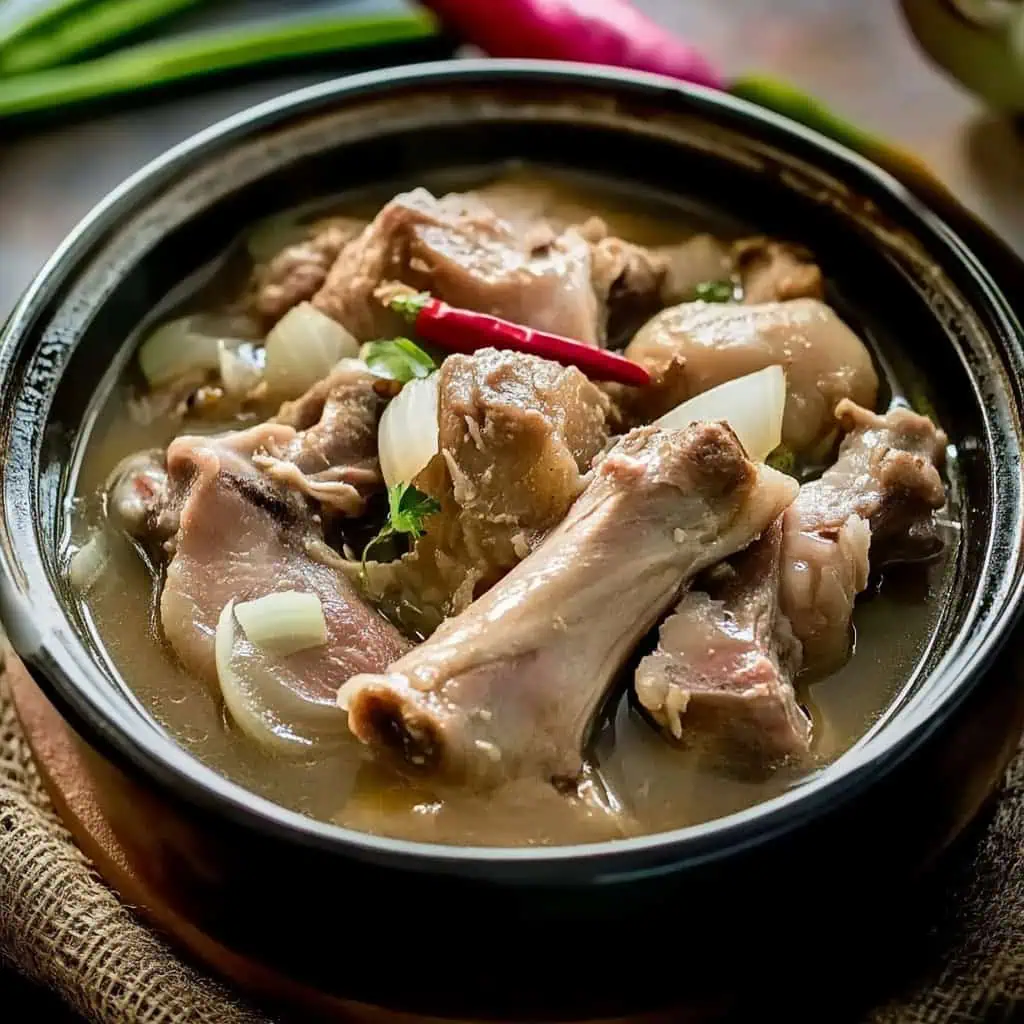
Why You'll Love This Recipe
This authentic Batangas-style Paksiw na Pata captures the essence of Filipino home cooking with its simplicity and bold flavors. The long, slow braising process transforms tough pork cuts into fork-tender meat, while the vinegar-based broth creates a perfectly balanced sour soup that's incredibly satisfying with steaming rice.
Ingredients
The ingredients in this Batangas-style Paksiw na Pata were chosen to create a perfectly balanced dish that highlights traditional Filipino flavors. Pork leg provides rich meat and collagen that becomes tender and flavorful during slow cooking. Pure cane vinegar serves as the star ingredient, offering the signature sourness without needing soy sauce.
Garlic and onions create an aromatic base, while whole peppercorns and bay leaves add depth and complexity. Green chilies bring a gentle heat that complements the sourness. Fish sauce adds the necessary saltiness and umami that ties everything together.
This carefully curated combination showcases how just a few quality ingredients can create a dish with remarkable depth and authentic provincial character.
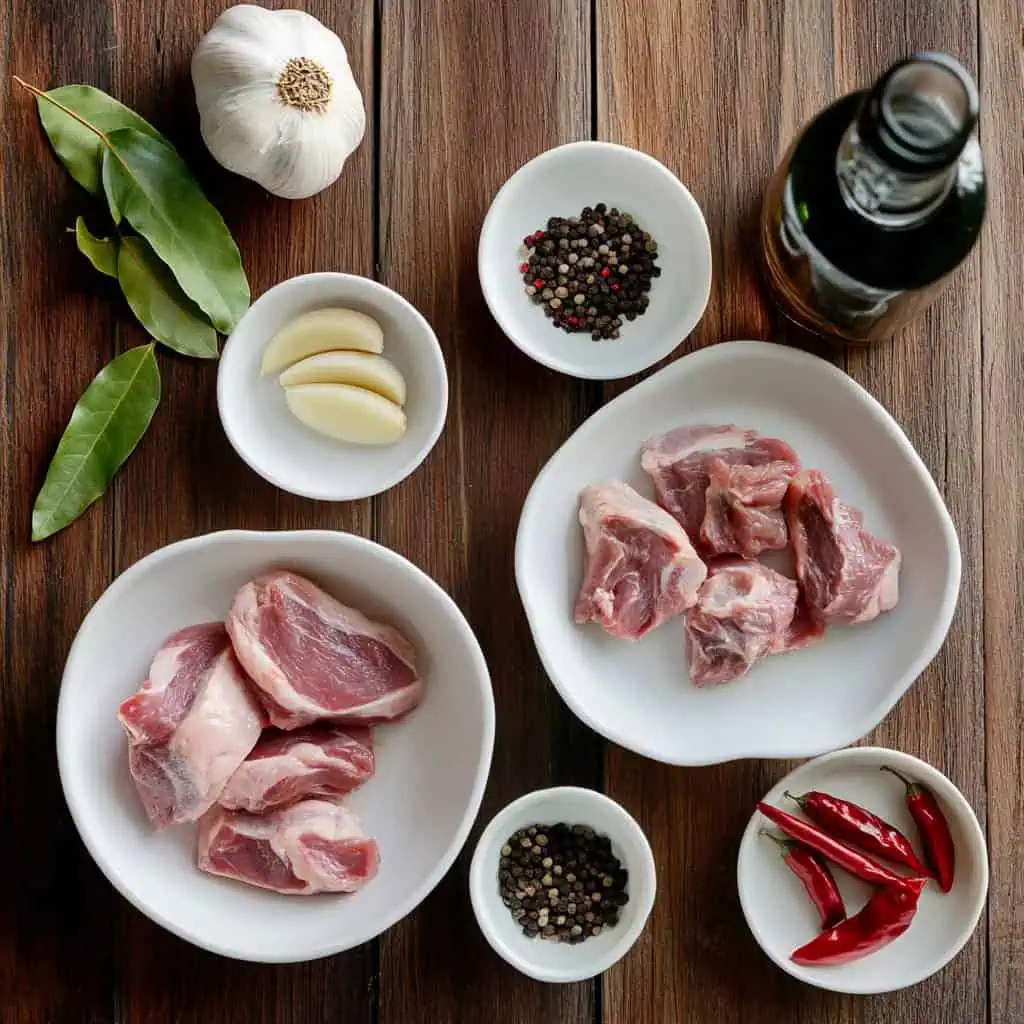
- 1.5 kg pork leg (pata), sectioned into 2-inch pieces
- ½ cup cane vinegar
- 1 whole head garlic, halved crosswise
- 2 medium red onions, quartered
- 3 tablespoons whole black peppercorns
- 3 pieces bay leaves
- 3 pieces green chilies
- Fish sauce to taste
- Water for braising
Equipment
- Large heavy-bottomed pot (kaldero) - Ensures even heat distribution during the long braising process, preventing hot spots that could burn the meat.
- Sharp knife - Essential for properly sectioning the tough pork leg into manageable pieces.
- Measuring cups - For precise liquid measurements, especially important for the vinegar ratio.
- Strainer - Used for removing scum during initial boiling, which helps achieve a clearer broth.
- Ladle - Necessary for skimming the surface and serving the finished dish.
- Kitchen tongs - Makes handling large meat pieces safer and easier during the cooking process.
- Earthenware pot (palayok) - Optional but recommended for authentic flavor development.
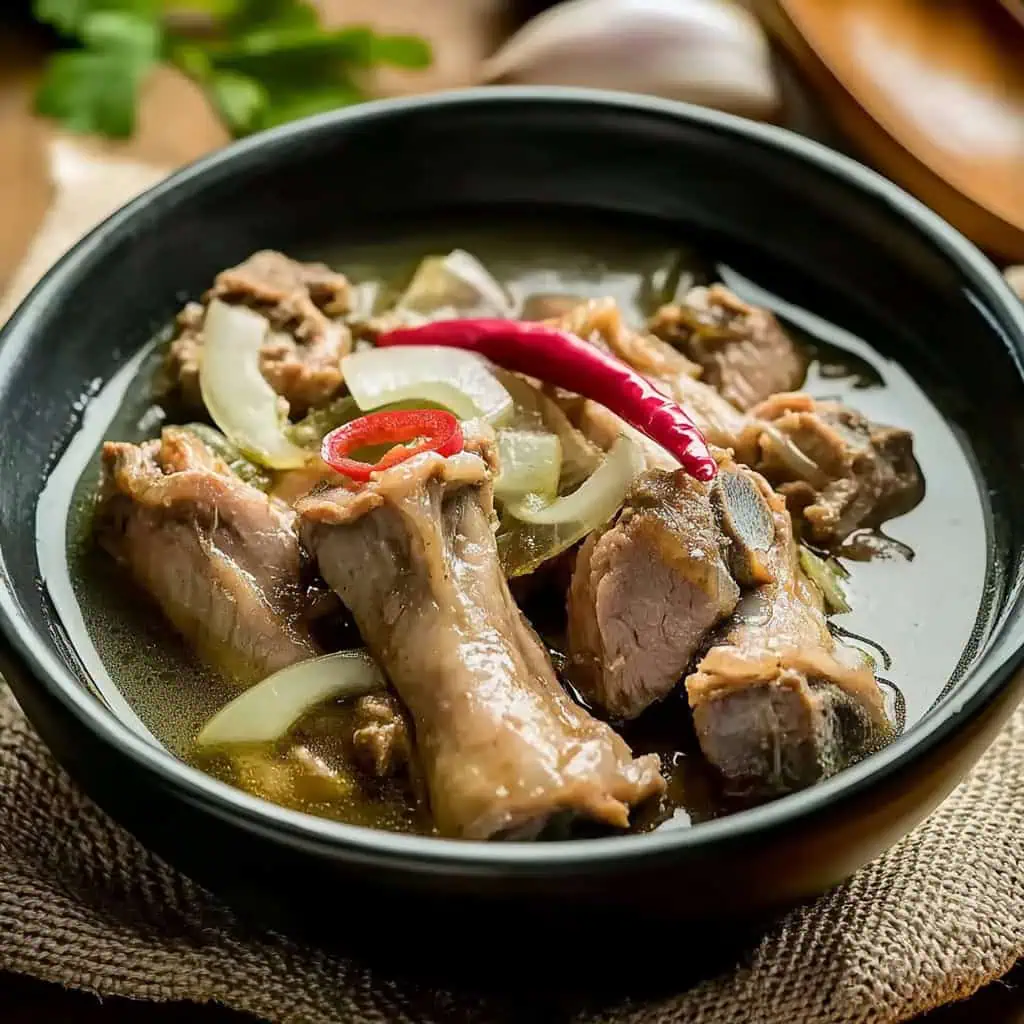
How To Make
- First, cut the pork leg into 2-inch sections and check that you have all ingredients ready. Set up a large pot on your stove.
- Put the pork sections in the pot and add enough water to cover them completely. Turn the heat to high and let it come to a boil. Keep boiling for 5 minutes to clean the meat.
- Drain all the water and rinse the pork pieces under cold water to remove any gray scum. Clean your pot well too – this step makes sure your final dish will have a nice clear broth.
- Put the cleaned pork back in the pot. Add the halved garlic head, peppercorns, and bay leaves. Pour in just enough fresh water to barely cover the meat. Bring to a boil, then lower the heat until it's gently simmering. Cook like this for 45 minutes, adding a little hot water if needed to keep the meat partly covered.
- After 45 minutes, add your quartered red onions, green chilies, and cane vinegar. Here's an important tip – don't stir after adding the vinegar if you want a clear broth. Add fish sauce to taste. Keep simmering for another 30 minutes or until you can easily pull the meat apart with a fork.
- Once the meat is tender, turn off the heat and let everything rest for 10-15 minutes. This makes the meat even more flavorful.
- Serve hot in a deep bowl with plenty of steamed rice. Put extra fish sauce, chilies, and vinegar on the table so everyone can adjust the taste to their liking.
- For the best experience, mix a little dipping sauce in a small bowl with some extra vinegar, minced garlic, and chilies. This lets you add extra sour and spicy flavors to each bite just the way you like it.

Tips from Lola's Kitchen
- Use pure cane vinegar (suka ng tubo) for authentic flavor. The quality of your vinegar directly impacts the final taste of this dish.
- Never stir after adding vinegar – this is crucial for maintaining a clear, beautiful broth.
- Pre-boil and clean the meat thoroughly before the actual cooking process begins. This removes impurities and results in a cleaner tasting dish.
- Cook in an earthenware pot (palayok) if available. The porous nature of clay helps develop deeper flavors.
- Control the heat carefully throughout the cooking process – the dish should simmer gently, never boil rapidly.
- Allow the finished dish to rest for at least 30 minutes before serving to let flavors fully develop and meld together.
- Prepare this dish a day ahead if possible – like many stews, the flavors improve significantly overnight.
Substitutions
- Pork Cuts: If pork leg isn't available, you can use pork belly (liempo), shoulder (kasim), or hocks with similar results. Each cut will bring a slightly different texture and fat content.
- Vinegar: While cane vinegar is traditional, you can substitute palm vinegar (suka ng tuba) or white vinegar in a pinch. Adjust the amount as white vinegar tends to be sharper.
- Chilies: Dried chilies or red pepper flakes can replace fresh green chilies if needed. Start with less and adjust to your heat preference.
- Onions: White onions or shallots can replace red onions, though they will provide a slightly different flavor profile.
- Aromatics: If you're short on bay leaves, a small piece of lemongrass can provide an interesting alternative aromatic note.
- Patis: If you don't have fish sauce, sea salt can work as a substitute, though you'll miss some of the umami depth.
Troubleshooting
- Meat is tough even after long cooking: Continue simmering at low heat until tender. Some pork legs may need up to 2 hours total cooking time depending on the animal's age.
- Broth is too sour: Add small amounts of water gradually to dilute, or balance with a tiny pinch of sugar.
- Broth turns cloudy: This usually happens from stirring after adding vinegar or boiling too vigorously. Skim the surface more frequently and maintain a gentle simmer.
- Too salty: Add a quartered potato to absorb excess salt, or dilute with a bit more water and vinegar.
- Lacks depth of flavor: Let the dish rest longer before serving, ideally overnight in the refrigerator.
- Sauce is too thin: Continue simmering uncovered to reduce the liquid, but be careful not to overcook the meat.
- Sauce is too thick: Add a small amount of hot water until desired consistency is reached.
Storage & Reheating
- Refrigeration: Store in an airtight container for up to 4 days. The flavor actually improves for the first 2-3 days as the ingredients continue to meld.
- Freezing: Can be frozen for up to 3 months in freezer-safe containers. Divide into portion sizes for easier reheating.
- Proper Cooling: Always let the dish cool completely before refrigerating or freezing to prevent bacterial growth.
- Reheating: Simmer gently on the stovetop until thoroughly heated. Avoid microwaving as it can make the meat tough and unevenly heated.
- Adding Freshness: When reheating, add a few drops of fresh vinegar just before serving to brighten the flavors that may have dulled during storage.
- Separation: If fat solidifies on top after refrigeration, you can either remove it for a lighter dish or mix it back in for more richness.
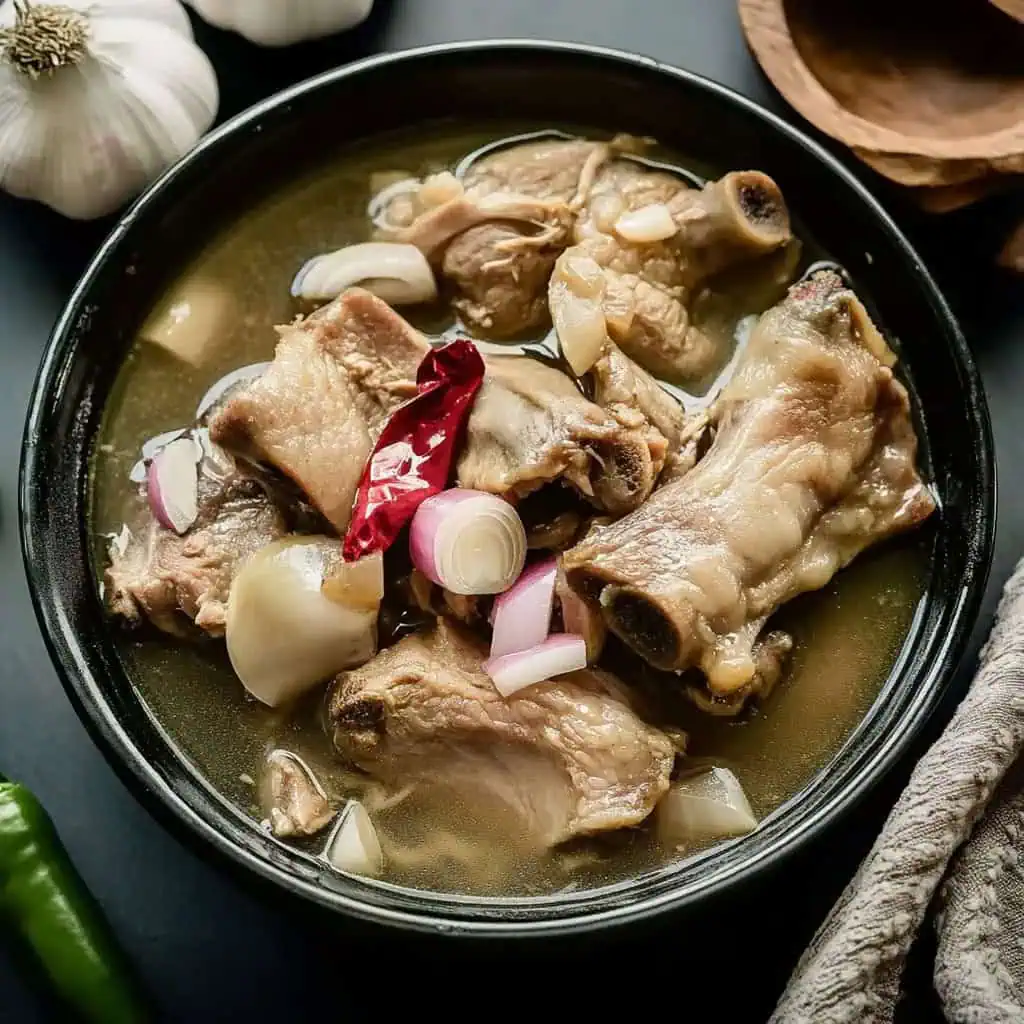
FAQ
Why doesn't this version use soy sauce?
This is the traditional Batangas style that focuses on pure vinegar-based flavors. The absence of soy sauce allows the natural flavors of the meat and aromatics to shine through.
How do I know when the pork is perfectly done?
The meat should easily fall off the bone when pierced with a fork, but still maintain its structure. If it's falling apart completely, it's slightly overcooked but still delicious.
Can I make this in a pressure cooker or slow cooker?
Yes, for pressure cooker, cook for about 30 minutes after the initial boiling and cleaning. For slow cooker, cook on low for 6-8 hours. In both cases, add the vinegar during the last part of cooking.
Is this dish supposed to be very sour?
It should have a pronounced sourness balanced by the richness of the pork and the aromatic elements. The fish sauce adds saltiness and depth that complements the sourness.
Can I make this dish ahead for a party?
Absolutely! The flavors actually improve when made 1-2 days ahead. Simply reheat gently before serving.
Why is my broth not clear like in traditional versions?
The key is not stirring after adding the vinegar and maintaining a gentle simmer throughout the cooking process. Also, thoroughly cleaning the meat and pot after the initial boiling is crucial.
Can I add vegetables to this dish?
While not traditional for Batangas-style paksiw na pata, you could add banana blossoms or eggplant during the last 15 minutes of cooking if desired.
How spicy should this dish be?
Traditionally, it's mildly spicy with the green chilies providing more flavor than heat. You can adjust the spice level by increasing or decreasing the amount of chilies.
Related
Looking for other recipes like this? Try these:
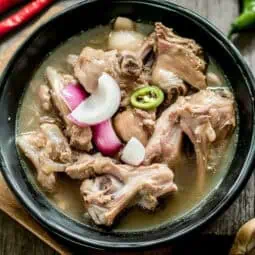
Paksiw na Pata Batangas Style (Traditional Vinegar-Braised Pork Leg)
Equipment
- Large heavy-bottomed pot (kaldero) For even heat distribution during long braising
- Sharp knife (kutsilyo) For sectioning the pork leg
- Measuring cups (tasa) For precise liquid measurements
- Strainer [Salaan] For removing scum during initial boiling
- Ladle - sandok For skimming and serving
- Kitchen tongs (Sipit) For handling large meat pieces
Ingredients
- 1.5 kg pork leg pata, sectioned into 2-inch pieces
- ½ cup cane vinegar suka ng tubo
- 1 whole head garlic isang ulo ng bawang, halved crosswise
- 2 medium red onions sibuyas, quartered
- 3 tablespoons whole black peppercorns paminta
- 3 pieces bay leaves dahon ng laurel
- 3 pieces green chilies siling haba
- Fish sauce patis to taste
- Water tubig for braising
Instructions
- First, cut the pork leg into 2-inch sections and check that you have all ingredients ready. Set up a large pot on your stove.
- Put the pork sections in the pot and add enough water to cover them completely. Turn the heat to high and let it come to a boil. Keep boiling for 5 minutes to clean the meat.
- Drain all the water and rinse the pork pieces under cold water to remove any gray scum. Clean your pot well too – this step makes sure your final dish will have a nice clear broth.
- Put the cleaned pork back in the pot. Add the halved garlic head, peppercorns, and bay leaves. Pour in just enough fresh water to barely cover the meat. Bring to a boil, then lower the heat until it's gently simmering. Cook like this for 45 minutes, adding a little hot water if needed to keep the meat partly covered.
- After 45 minutes, add your quartered red onions, green chilies, and cane vinegar. Here's an important tip – don't stir after adding the vinegar if you want a clear broth. Add fish sauce to taste. Keep simmering for another 30 minutes or until you can easily pull the meat apart with a fork.
- Once the meat is tender, turn off the heat and let everything rest for 10-15 minutes. This makes the meat even more flavorful.
- Serve hot in a deep bowl with plenty of steamed rice. Put extra fish sauce, chilies, and vinegar on the table so everyone can adjust the taste to their liking.
- For the best experience, mix a little dipping sauce in a small bowl with some extra vinegar, minced garlic, and chilies. This lets you add extra sour and spicy flavors to each bite just the way you like it.
Tips from Lola's Kitchen
- Use pure cane vinegar for authentic flavor
- Never stir after adding vinegar; this keeps the sauce clear
- Cook in an earthenware pot (palayok) if available for better flavor
- Let dish rest for 30 minutes before serving for flavors to meld
Nutrition
The Story Behind Paksiw na Pata Batangas Style
Deep in the heart of Batangas province, where sugarcane fields stretch toward distant volcanoes, a unique culinary tradition has been quietly preserved through generations. Paksiw na Pata Batangas Style stands apart from its more commonly known counterpart, telling a story of resourcefulness and provincial wisdom that characterizes authentic Filipino cuisine.
Unlike the widespread version that incorporates soy sauce, this heritage preparation speaks to a time when coastal and inland communities relied primarily on local ingredients. The abundance of sugarcane in Batangas led to the production of exceptional cane vinegar (suka ng tubo), which became the cornerstone of this dish. This vinegar, known for its clean, sharp acidity and subtle sweetness, transformed humble pork cuts into a delicacy that would become emblematic of Batangueño home cooking.
The method of preparing Paksiw na Pata in Batangas reveals the sophisticated understanding of flavor development that Filipino home cooks possessed. The initial boiling and cleaning process, while seemingly simple, is a crucial technique that ensures the final dish achieves its characteristic clear broth. This clarity isn't merely aesthetic – it represents the purity of flavors that defines provincial Filipino cuisine.
What makes this preparation particularly noteworthy is its economic practicality. In an era before refrigeration was commonplace, vinegar-based cooking methods like paksiw served as both a preservation technique and a way to tenderize tougher cuts of meat. The dish exemplifies how Filipino cooks could transform affordable ingredients into meals that would sustain families through long working days in the fields.
The absence of soy sauce in this version isn't a limitation but rather a deliberate choice that highlights the complex interplay between vinegar, aromatics, and pork. This preparation method allows the natural flavors of the meat to shine through, creating a dish that's simultaneously rustic and refined. The resulting flavor profile, reminiscent of sinigang but distinctly its own, demonstrates how regional cooking styles contribute to the rich tapestry of Filipino culinary heritage.
Today, as modern Filipino cuisine continues to evolve and gain international recognition, dishes like Batangas-style Paksiw na Pata serve as important reminders of our culinary roots. They tell the story of how provincial cooks could create remarkable flavors with minimal ingredients, guided by an intimate understanding of their local produce and a deeply ingrained cooking philosophy that valued simplicity and sustainability.
This heritage recipe has endured not just because of its practicality, but because it embodies the essence of Filipino cooking – the ability to create something extraordinary from ordinary ingredients, transforming necessity into culinary artistry. In every bowl of this clear, sour broth, we taste the wisdom of generations of Filipino cooks who understood that true flavor doesn't always require complexity, just respect for ingredients and tradition.










Comments
No Comments